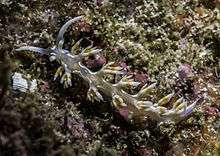Flabellina engeli
Flabellina engeli is a species of sea slug, an aeolid nudibranch, a marine gastropod mollusc in the family Flabellinidae.[2]
| Flabellina engeli | |
|---|---|
 | |
| The nudibranch Flabellina engeli lucianae, Cabo Frio, Brazil. | |
| Scientific classification | |
| Kingdom: | |
| Phylum: | |
| Class: | |
| (unranked): | clade Heterobranchia clade Euthyneura clade Nudipleura clade Nudibranchia clade Dexiarchia clade Cladobranchia clade Aeolidida |
| Superfamily: | |
| Family: | |
| Genus: | |
| Species: | F. engeli |
| Binomial name | |
| Flabellina engeli Ev. Marcus & Er. Marcus, 1968[1] | |
Subspecies
A subspecies has been described from colder water in Brazil as Flabellina engeli lucianae Dacosta, Cunha, Simone & Schrödl, 2007.[3]
Distribution
This species was described from Curaçao. It has been reported from Tobago, Florida,[4] Costa Rica, Colombia, Venezuela, Barbados, Cuba, Puerto Rico, Curaçao, St. Lucia, Martinique, Granada, Brazil and Panama.[5]
Description

Body is elongate, narrowing posteriorly.[5] Rhinophores are lamellate, club-shaped and with white bands.[5] Cerata are arranged into clusters in two rows along the dorsum.[5] Background color is translucent gray with thick white or yellow patches running between the cerata clusters, on the margin of the dorsum.[5] A submarginal row of opaque white spots present along the sides of the body.[5] Three white or yellow patches are on the head.[5] Oral tentacles are long, translucent and white at the tips.[5] Cerata are translucent with a brown or orange band about a third of the way down from the tip.[5] The maximum recorded body length is 25 mm.[5][6]
Ecology
One specimen was found on a living blade of sea grass in 1 m of water in Panama.[5] Minimum recorded depth is 1 m.[6] Maximum recorded depth is 2 m.[6]
References
This article incorporates Creative Commons (CC-BY-4.0) text from the reference[5]
- Marcus Ev. & Marcus Er. (1968). "Flabellina engeli, a new nudibranch from Curaçao". Beaufortia, Zoological Museum Univ. Amsterdam, 15: 139-142.
- Bouchet, P. (2015). Flabellina engeli Ev. Marcus & Er. Marcus, 1968. In: MolluscaBase (2015). Accessed through: World Register of Marine Species on 2015-10-26
- DaCosta S., Cunha C. M., Simone L. R. L. & Schrödl M. (2007). "Computer-based 3-dimensional reconstruction of major organ systems of a new aeolid nudibranch subspecies, Flabellina engeli lucianae, from Brazil (Gastropoda : Opisthobranchia)". Journal of Molluscan Studies 73(4): 339-353. doi:10.1093/mollus/eym035.
- Rudman W. B. (2001, October 8). Flabellina engeli Marcus & Marcus, 1968. Sea Slug Forum. Australian Museum, Sydney.
- Goodheart J. A., Ellingson R. A., Vital X. G., Galvão Filho H. C., McCarthy J. B., Medrano S. M., Bhave V. J., García-Méndez K., Jiménez L. M., López G. & Hoover C. A. (2016). "Identification guide to the heterobranch sea slugs (Mollusca: Gastropoda) from Bocas del Toro, Panama". Marine Biodiversity Records 9(1): 56. doi:10.1186/s41200-016-0048-z
- Welch J. J. (2010). "The “Island Rule” and Deep-Sea Gastropods: Re-Examining the Evidence". PLoS ONE 5(1): e8776. doi:10.1371/journal.pone.0008776.